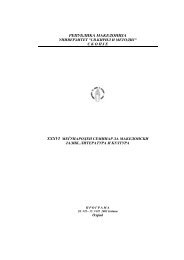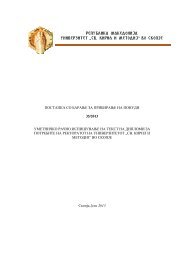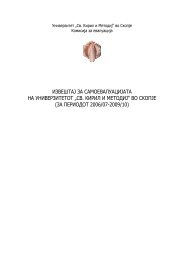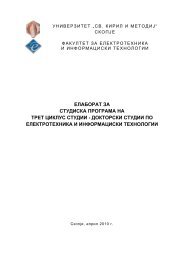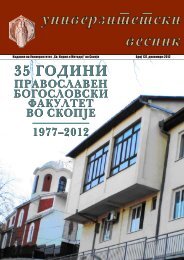УНИВЕРЗИТЕТ „СВ. КИРИЛ И МЕТОДИЈ“ – СКОПЈЕ
УНИВЕРЗИТЕТ „СВ. КИРИЛ И МЕТОДИЈ“ – СКОПЈЕ
УНИВЕРЗИТЕТ „СВ. КИРИЛ И МЕТОДИЈ“ – СКОПЈЕ
Create successful ePaper yourself
Turn your PDF publications into a flip-book with our unique Google optimized e-Paper software.
156<br />
/a/ The phoneme /a/ is always written with the grapheme . In the<br />
Lower Vardar dialect, the non-stressed /a/ reduces to /ă/. These two sounds are<br />
not distinguished in the manuscript, which makes the study of this particular<br />
reduction very difficult.<br />
/ă/ This phoneme is always written with an , which is problematic as<br />
it is homographic with the phoneme /a/. However, closer scrutiny of the supposed<br />
minimal pair sam <strong>–</strong> săm (the former being a pronominal adjective, the<br />
latter a verb) reveals that, in the beginning of the manuscript, the pronominal<br />
adjective is written with an acute accent and the verb with a circumflex, perhaps<br />
copying the accent of the Greek first person singular of the verb “to be”,<br />
εἶμαι. Distinguishing between the homographic words in this manner could be<br />
due to the influence of Church Slavonic, but again, in this particular case, the<br />
Greek graphotactics probably explains the phenomenon. The verb săm appears<br />
several times in the text before the pronominal adjective. When the pronominal<br />
adjective occurs the first time, it is written in the plural σάμη. The Greek<br />
graphotactics does not permit the circumflex to be written on the penultimate<br />
syllable, if the last letter represents an etymologically long vowel, as η does.<br />
Consequently, when the pronominal adjective appears the next two times in<br />
the text in the singular, it has the acute accent.<br />
Yet, further into the manuscript, the writer uses the circumflex both to<br />
write the pronominal adjective and the verb. Paradoxically, in a passage where<br />
the homography of these words might cause confusion, the writer uses the circumflex<br />
for both words: Vidéjte rácite mi i nózite mi: óti sâm (pron. adj.) jáze<br />
sâm 4 (verb). It is nonetheless understandable that the writer did not necessarily<br />
feel the need to distinguish between these two phonemes in the writing, as the<br />
only minimal pair in the text consists of a pronominal adjective and a verb,<br />
which are fairly easy to discern from the context.<br />
It is also likely that the writer has also used the grapheme in clitic<br />
singular accusative personal pronouns (standard Macedonian ме, те, се) to express<br />
the phoneme /ă/. These are almost always written as μά, τά, and σά.<br />
/b/ This phoneme is almost always written with the digraph . Yet<br />
in the verb zburúva, /b/ is most often written with a : ζπγργ΄βα. Perhaps a<br />
sequence of three consonantal graphemes did not seem desirable. It is evident<br />
that the writer has pursued a progressive assimilation, common in the Greek<br />
language, as the nasal <strong>–</strong> stop sequences demonstrate.<br />
/v/ This phoneme is written with a . It is also represented by the historical<br />
diphthongs , as in the word Εύάγγελιε. There is much variation<br />
between /v/ and the voiceless allophone [f]. For example, in the beginning of<br />
the text, the author writes cárstfutu, but later the word occurs only in the form<br />
cárstvutu. When it comes to this allophony, the writing system of the Konikovo<br />
Gospel is mainly phonetic.<br />
4<br />
Bibl.Patr.Alex.268: 35






